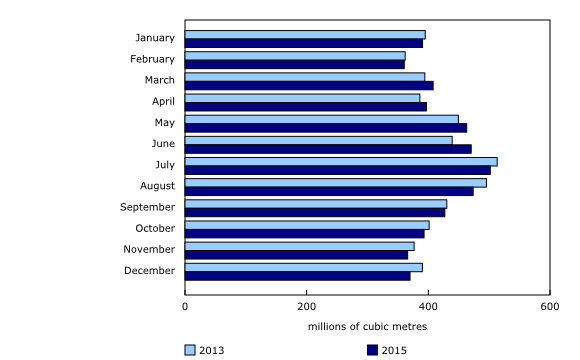Survey of Drinking Water Plants, 2015
Archived Content
Information identified as archived is provided for reference, research or recordkeeping purposes. It is not subject to the Government of Canada Web Standards and has not been altered or updated since it was archived. Please "contact us" to request a format other than those available.
Released: 2017-11-01
Drinking water plants produced 5 020 million cubic metres of potable water in 2015, down slightly from 2013.
The number of people who received their drinking water from plants that served communities of 300 or more rose from just under 30 million in 2013 to 30.7 million people in 2015.
Total per capita water use, which includes residential, industrial, commercial and other uses of water provided by public utilities, averaged 447 litres per person per day in 2015, down 3% from 460 litres per person per day in 2013. The decline in per capita water use was the result of an increase in population, while drinking water production remained constant.
The residential sector was the principal water user, averaging 235 litres per person per day in 2015. This worked out to 2 511 million cubic metres or 50% of the drinking water produced.
The industrial, commercial, institutional and other non-residential uses combined used 1 434 million cubic metres (29%) of water. Losses from the distribution system (such as leakage) made up 15% of the volume produced. The end-use for 3% of the total water volume (154 million cubic metres) was not reported or unknown to the respondent, or it could not be allocated to a particular sector. The remaining 3% was reported as wholesale transfers to other jurisdictions.
Surface water sources, such as lakes and rivers, supplied 88% of the water, with groundwater and other sources making up the rest.
Nearly all the water produced was treated by filtration and disinfection processes in 2015. Just 1% of the population received untreated water, which came primarily from groundwater sources, unchanged from 2013. Chlorination remained the most common disinfection process and was applied to 96% of all drinking water produced in 2015.
Capital expenditures
Just under $700 million in capital expenditures were made to upgrade existing infrastructure and commission new components of water treatment plants in 2015.
These upgrades included improvements to buildings, machinery, processing equipment, and other physical assets related to the acquisition and treatment of water, but excluded infrastructure for water distribution. Capital expenditures were down 4% in 2015 from the previous year, and were down 32% from 2013.
Operation and maintenance costs
In 2015, just over $1 billion was spent on operations and maintenance. These costs included expenditures on materials (chemicals and replacement parts), labour and energy, but excluded water distribution costs.
Labour costs were the largest component of these expenses at $419 million, followed by energy expenses ($239 million) and materials ($236 million). Other costs accounted for the remaining $120 million. Total operation and maintenance costs were 4% higher than in 2013.

In celebration of the country's 150th birthday, Statistics Canada is presenting snapshots from our rich statistical history.
In 1916, Canada's Commission of Conservation published statistics on water-works plants in Canada dating back to the mid-1800s, shortly before Confederation in 1867. Prior to 1850, three water-works plants operated in Canada, Halifax (since 1848), Toronto (since 1841) and Saint John, New Brunswick, the oldest in Canada, which began operation in 1837.
By 1915, there were over 500 water-works plants operating in nine provinces with a total daily production of close to 427 million imperial gallons (just over 700 million cubic metres annually). These plants served about 3.8 million people, nearly half the population of Canada, who were living mainly in urban areas. The reported total daily consumption per capita was 111 imperial gallons (just over 500 litres per person per day). During the same period, it was determined that public health could be protected by treating water through chlorination, a process that was introduced to Canadian municipal water supplies in 1910.
A century later, data from the 2015 Survey of Drinking Water Plants indicate just over 5 000 million cubic metres of potable water was produced by nearly 2,000 drinking water plants in 10 provinces and 3 territories. These facilities withdraw raw water from surface and groundwater resources to serve nearly 31 million people or close to 90% of the Canadian population, with an average daily total per capita use of just under 450 litres per person per day. Treatment of drinking water has also evolved over the past 100 years with the development of filtration systems that use various granular media and others that use membranes. Today, nearly all of the potable water produced is disinfected by chlorination.
Note to readers
The target population is composed of drinking water treatment plants that are licensed and regulated by provincial/territorial agencies (excluding First Nations communities) and that draw and process source/raw water from the environment to produce treated/potable water for consumption, serving 300 or more people.
Contact information
For more information, contact us (toll-free 1-800-263-1136; 514-283-8300; STATCAN.infostats-infostats.STATCAN@canada.ca) or Media Relations (613-951-4636; STATCAN.mediahotline-ligneinfomedias.STATCAN@canada.ca).
- Date modified:


